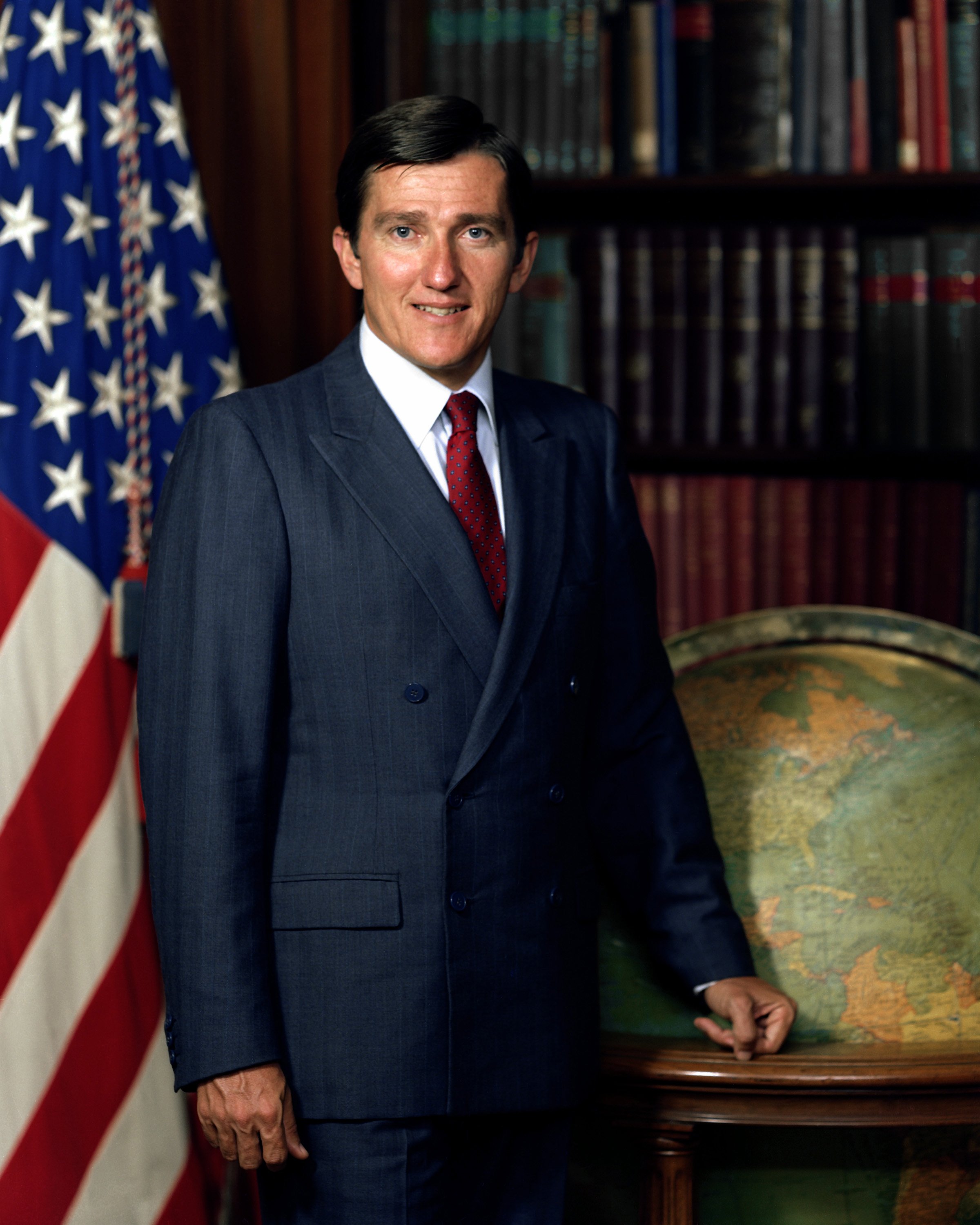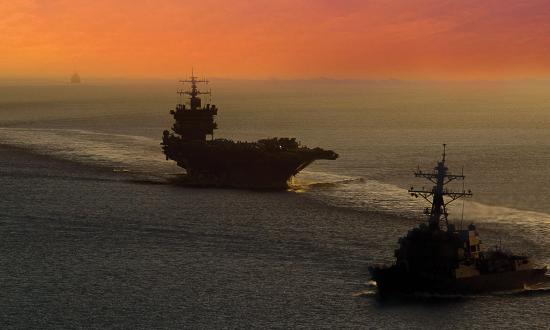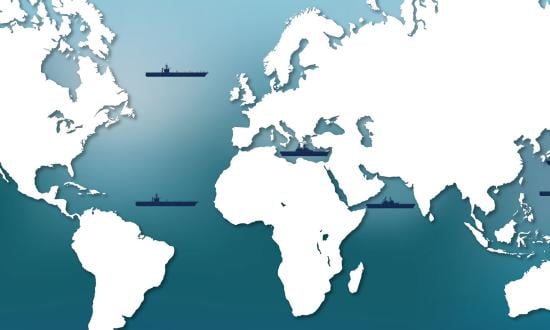THE 1970s
The U.S. Navy emerged from the Vietnam War into a different world than that preceding the 1964 Tonkin Gulf incident. In some ways “it was the best of times, it was the worst of times.” Chief of Naval Operations (CNO) Admiral Elmo “Bud” Zumwalt was one of the most energetic and thoughtful officers to occupy that position, to be followed by two equally astute leaders—Admirals James Holloway and Thomas Hayward. Navy Secretary Graham Claytor (1977–79), a decorated World War II destroyer escort commander, was a powerful naval influence on Defense Secretary Harold Brown.
They and their staff officers developed and published their visions and concepts in a succession of cogent documents—Project Sixty, “Missions of the U.S. Navy,” Sea Plan 2000, Strategic Concepts of the U.S. Navy (NWP-1), the Sea Strike Strategy, and “The Future of U.S. Seapower”—that stimulated intense debate within the naval service (often in the pages of Proceedings) and would serve as springboards for the Maritime Strategy efforts of the 1980s. Vice Admiral Stansfield Turner’s transformation of the strategy curriculum at the Naval War College was sustained by subsequent CNOs and War College presidents, all of whom strove to boost Navy student officer attendance as well.
But successive Congresses—transfixed by wrongheaded notions of détente, peace dividends, and a narrow focus on only a few areas of the globe—often pushed back against the Navy’s views and refused to allocate sufficient funding to implement them.
Having for decades accepted overwhelming Soviet superiority on the ground in central Europe, U.S. defense planners worried that the capability gap there between the Warsaw Pact and NATO had only grown during the Vietnam War, destabilizing the overall East-West military balance. Likewise, U.S. nuclear superiority over the Soviets had given way to parity. In such a situation, reestablishing U.S. maritime superiority was critical to maintain overall stability. Yet Pentagon planners themselves helped the Soviets chip away at that superiority, as they sought to trade resources needed by U.S. maritime forces for an obsessive focus on central Europe and land-based forces.
The Navy’s ship designers, naval architects, aviation engineers, and associated contractors fashioned a new generation of fast, lethal, and sophisticated warships, aircraft, and weapons, including Nimitz-class carriers, Los Angeles–class submarines, Spruance-class destroyers, and Oliver Hazard Perry-class frigates. Force levels plummeted, however, as worn out and obsolete hulls and airframes from World War II, Korea, and Vietnam were retired.
The Navy was populated by operators who were seasoned in forward operations under the sea, in the air, and in combat close to shore. But its mess decks were roiled by racial tensions, and drug abuse was rampant. The service honed scores of smart officers skilled in operations analysis, politico-military affairs, and strategic planning, who—due to demanding repeat staff tours and appropriate high-level education—understood the nature and benefits of the Navy in keeping the country safe. But the CNO’s staff (OpNav) was riven by community stovepipes and intraservice budget battles as defense spending tumbled and shipbuilding costs soared.
Admiral Zumwalt dealt brilliantly with the service’s racial issues. He also refocused the Navy on the Soviet threat, expressing particular concern over the Soviet Navy’s capability to interdict sea lines of communications between the United States and its allies across the Atlantic and Pacific. Analysts at the Center for Naval Analyses (CNA), the Navy’s federally funded research and development center, shared the CNO’s concern but believed that the main wartime Soviet naval effort would be to deploy ballistic-missile submarines as a strategic reserve in far-northern ocean bastions, protected by most of their remaining warships (which would deploy at ever-greater distances from the bastions as their capabilities improved, effectively severing the western sea lines of communication as a secondary effect). Late in the decade, the Intelligence Community, including the Office of Naval Intelligence (ONI), using some still–highly classified data and analyses, sided with CNA and began to educate the Navy’s operators.
Through it all, in response to national tasking, the Navy continued to deploy forward as much of the fleet as it could to enhance deterrence against the Soviets, reassure global allies, help resolve crises, and maintain its combat edge. Meanwhile, the Soviets continued their massive naval building program; developed worrisome naval employment concepts of their own; increased their combat reach from their home bases; and developed advanced naval bases in Cuba, east and west Africa, the Middle East, and—most galling of all—Cam Ranh Bay, in what was now the Socialist Republic of Vietnam. Soviet design bureaus developed imaginative new submarine and surface warship designs, and Soviet shipyards built them in quantity, along with a new generation of offensive, long-range, land-based naval aircraft.
The U.S. Navy had its own string of advanced bases around the world that it could use, and it was allied with most of the world’s other naval powers. Despite the defeat in Vietnam, most of those bases remained available, with a new base at Diego Garcia in the Indian Ocean showing great promise. Allies, for the most part, stuck by the United States, although many of their fleets—especially in Europe—grew progressively smaller. With the increased sophistication of evolving C3 systems, however, interoperability among the navies of the western alliance required constant tending by the leading power, the U.S. Navy. Transfer of precious but essential technological secrets was a growing issue, and—unbeknownst to the United States and its allies—spies were poking holes in the blankets of secrecy that cloaked many of their activities.
Throughout the 20th century, the U.S. Navy had become famous for the quantity and quality of its at-sea exercises. The Cold War reoriented the service’s exercise program to the Mediterranean, North Atlantic, and northeast Pacific, to improve combat readiness, experiment with new tactics and gear, reassure allies, and signal resolve to the Soviets. Throughout the Vietnam War, the Navy continued this rigorous exercise program, but by the late 1970s—in the interests of détente and false economies—it pulled in its horns. The U.S. Navy even began treating the Norwegian Sea as if it were a Soviet lake, much to Moscow’s delight.
Since the 19th century, the Navy had developed—at the Naval War College and elsewhere—a considerable war-gaming competence, gaining insights in ways not possible on the high seas. By the 1970s, however, the gaming was focused on examining discrete tactics—a worthy focus but neglectful of global maritime strategy. Fortunately, Naval War College professor Francis J. “Bing” West and others at Newport realized this shortcoming, and—once they were done working on Seaplan 2000—turned their attention to creating and implementing a new annual Global War Game, starting in 1979.
All of these developments—positive and negative—were magnified as the Carter administration entered its final years. Defense Secretary Harold Brown continued to support Navy development of extraordinary new systems, including the Aegis combat system, the SLQ-32 electronic warfare system, and others, but he did not provide enough funding to procure them in numbers. The Navy’s ship count continued to drop, but demands for deployments increased. Crisis after crisis required emergency deployments and repositioning naval power worldwide. But the administration continued to focus mostly on building up military power in West Germany, until the Iranian revolution and the Soviet invasion of Afghanistan illustrated the limits of such a narrow perspective.
Meanwhile, the intellectual ferment in the U.S. Navy began to have positive second-order effects. Successive CNOs built on the ideas of their predecessors. Admiral Holloway’s Naval Warfare Publication 1, Strategic Concepts of the U.S. Navy (NWP-1), emphasized the importance of seeing the Navy as an integrated body of warfare areas—strike, antisubmarine, antisurface, antiair, and amphibious—instead of a series of semiautonomous subsurface, surface, air, and special warfare stovepipes. This was reinforced by Admiral Hayward’s encouragement of the composite warfare commander (CWC) concept for carrier battle group command and control. CNO Hayward created a Directorate for Naval Warfare, organized by warfare areas, within OpNav, to help shape the Navy’s program objective memorandum (POM) and annual budget proposals and to foster better integration of platforms and weapons systems within the fleet. Admiral Hayward also reacted favorably to a recommendation by Robert Murray, the outgoing Under Secretary of the Navy, to set up a small cell of front-running officers, fresh from major command, to develop tactical and operational concepts that would be useful to OpNav and the fleet. As important, it would improve those officers’ own strategic and operational acumen, anticipating that many would later become influential flag officers. This group was established in Newport, Rhode Island, and called the Strategic Studies Group (SSG). Its first iteration was in 1981.
At the same time, the Navy continued to populate plans offices, especially in OpNav OP-06 and on fleet staffs, with appropriately educated and experienced experts in politico-military affairs and strategic planning. In 1978, Rear Admiral Robert Hilton, the Director for Strategy, Plans, and Policy (OP-60), reshuffled his team and put several leading strategists and NATO experts into a new Strategic Concepts Branch (OP-603), reporting directly to Hilton. His successor, Rear Admiral Arthur Moreau, continued this practice with enthusiasm.
Some OP-603 midgrade officers, along with denizens of other OpNav divisions, periodically came together on their own to argue about optimum approaches to address naval issues of the day. These meetings were professional but unofficial, informal, and not recorded. They were, however, yet another manifestation of the intellectual excitement within the naval officer corps of the time, in the face of a rising Soviet naval threat and U.S. administrations that did not appear to be responsive to the needs of the service—or the country—in maintaining maritime superiority.
THE 1980s
As the 1970s ended, the American people had had enough of the false promises of too-narrow objectives, détente, and peace dividends, as well as falling force levels and rising defense costs. The election of President Ronald Reagan in November 1980 ushered in an era of “peace through strength.” I was fortunate to be named Secretary of the Navy in the new administration. The President, a strong bipartisan group in Congress led by Senators John Tower and Scoop Jackson, and I were determined to refocus the Navy on three major efforts:
• Articulate an aggressive, forward-leaning, global maritime strategy, involving not just the U.S. Navy, but also the other services and our naval allies, as part of a new national security strategy to reestablish maritime supremacy. The goal was to demonstrate to the Soviets that they could not win a war against NATO and would bankrupt their economy if they tried to keep up.
• Increase the U.S. Navy force goal to 600 battle force ships, including 15 carrier battle groups, 100 submarines, and amphibious lift for one Marine amphibious force and one Marine amphibious brigade. These requirements were derived directly from the operational needs of each theater surrounding the Soviet Union.
• Reduce defense costs, especially for procurement, by fostering and enforcing competition among suppliers.
When the administration took office, we were able to use the institutions and processes already in place—but denied funding by the previous administration—to reestablish U.S. global naval superiority. Combined with simultaneous improvements in Army and Air Force resources and fighting concepts, these efforts stabilized overall global military deterrence in our favor. We also added a number of key new innovations.
The Naval War College and the Naval Institute—and their fora and media—provided the Reagan administration ready-made outlets to reach the Navy and Marine Corps officer corps and beyond with the concepts of a maritime strategy and maritime superiority. So too did routine hearings on the Hill convened by the Senate and House Armed Services Committees, mostly to explain and gain support for the 600-ship force goal. We were fortunate that President Carter’s Defense Secretary, Harold Brown, had continued critical Navy research, development, prototyping, and testing programs on new platforms and systems. Except in a few cases, all we had to do was fund and procure many more of these items in the fleet, and fast. We used other gatherings and media as well to spread the logic of the buildup, and many of these concepts and explanations were picked up and reported by the trade press and broader mainstream media.
When the CNO’s SSG convened its first annual cohort in Newport, called SSG I, six front-running officers were handpicked by CNO Hayward, each from a different warfare community. They were directed to examine a NATO sea campaign against the Soviet Union’s vulnerable Atlantic, Pacific, Arctic, and Mediterranean flanks, and they established links with the Naval War College’s War Gaming Center and the Navy’s recently repurposed Washington-based Advanced Technology Panel (ATP). A robust travel schedule had the SSG visiting and exchanging ideas with unified and fleet commanders and their staffs. Once the group’s work was underway, I met with them and their successors periodically to glean what they had learned and ensure they knew my views on the operational and tactical subjects they were studying. I also met on occasion with the informal naval discussion group of mid-level officers that was functioning as a precursor to the current Strategy Discussion Group. And in a widely reported speech at the National Press Club in August 1981, I laid out important policies to increase affordability and decrease costs, which we were already pursuing vigorously.
Most important, I ensured that three of the Navy’s most aggressive, offensive-minded, and tactically astute flag officers—Vice Admiral James A. “Ace” Lyons Jr. and Rear Admirals Hank Mustin and Jerry Tuttle—started to prepare for a seminal at-sea exercise in the fall of 1981. In this exercise, called Ocean Venture, the U.S. Second Fleet, NATO Striking Fleet Atlantic, and other forces would surge into the northern Norwegian Sea to demonstrate and practice what a forward maritime campaign entailed, including imaginative cover and deception tactics, techniques, and procedures. Similar exercises would follow every year in the Mediterranean, northeast Pacific, and Arctic—not just talking the talk but walking the walk of a global, forward, offensive campaign against the Soviets.
In 1982, things really came together. Forward exercises were conducted in the northern Pacific and Mediterranean. For the first time in 20 years, two U.S. Navy attack submarines surfaced together at the North Pole. SSG I war-gamed their hypotheses and presented their findings to the Navy leadership, then went to fleet and staff assignments to use what they had learned about strategy and operational art. SSG II convened and began to examine ingenious new offensive Mediterranean and Pacific campaigns. The annual Global War Game reconvened at Newport, with a Mediterranean-focused scenario. And the Intelligence Community published a widely usable National Intelligence Estimate at the secret level that laid out its consensus view of Soviet naval strategy and policy, which U.S. naval planners could use to develop countermeasures.
Meanwhile, the Navy’s uniformed leaders tasked the strategy whizzes in OP-60 to create the first public version of a maritime strategy brief for widespread circulation within the defense establishment. It was then used to kick off the annual POM build in the fall. OP-60 put together a classified briefing that exceeded all expectations. I approved the brief and used it enthusiastically. Admiral Hayward’s Warfighting Directorate (OP-095) used it in its warfare appraisals, which informed the next stage of POM development, made easier by the briefing’s focus on CWC warfare areas and by the assignment to OP-095 of numerous SSG alumni.
That strategy briefing became the basis for hundreds of briefings, usually by OP-603 strategists, to appropriate audiences at war colleges, service academies, congressional committees and subcommittees, academic and U.S. Naval Institute fora, and Washington, fleet, and allied staffs. By 1984, having “murder-boarded,” honed, and presented the briefing, OP-603 reformatted it as a printed classified OpNav document, with text and graphics, which was signed out by CNO Admiral Watkins. It was updated and expanded in 1985 and joined that year by a classified Amphibious Warfare Strategy, drafted by a Navy–Marine Corps team and signed by the CNO and the Commandant of the Marine Corps (CMC) jointly. In 1986, the CNO, CMC, and I published an unclassified version of the strategy in a special edition of Proceedings. The message was the same as that of my early speeches, articles, and testimony: (1) We have an appropriate and effective maritime strategy that will ensure our nation maintains its vital maritime superiority; (2) The minimum force needed to execute the strategy is 600 ships, including 15 carrier battle groups; and (3) We have instituted new procurement policies that are bringing down the cost to the American taxpayer of naval systems needed to build and sustain a 600-ship Navy and carry out the strategy.
The Navy of the 1980s began to include numerous new systems, notably, reengined F-14s, Aegis cruisers, Tomahawk land-attack and antiship cruise missiles, improved Los Angeles–class submarines, four recommissioned battleships, vertical launch systems, close-in weapons systems, SLQ-32, and more. Force levels went from 521 battle force ships in 1981 to 594 in 1987. The Navy also instituted and refined new operational and tactical organizations, concepts, and procedures, including O-6-level carrier air wing commanders (also known as Super CAGs), the Naval Strike Warfare Center in Fallon, Nevada (a.k.a. Strike U), outer air battle tactics, and operational maneuver from the sea, to name a few.
I left office as Secretary of the Navy in 1987. The forward maritime strategy, the 600-ship force goal, annual global exercises, and constant tactical innovation were firmly in place. My successors Jim Webb and Will Ball subscribed to them. So, too, did CNO Admiral Watkins’ successor Admiral Carl Trost, who published three Proceedings articles on the continued validity of the strategy, even as the Soviets began to buckle and Congress began again to slash defense budgets.
In fact, the largest of the global, aggressive, forward at-sea exercises was the enormous Pacific Exercise ’89 led by Admiral David Jeremiah. The Global War Games at Newport also continued, with an ever-expanding number of participants. Successive SSGs continued to respond to CNO tasking, including SSG VII, which evaluated the strategy in the Pacific for Admiral Trost in 1986–87, and SSG IX, which recommended that the CNO repurpose the group, since they saw the Soviets as finished as an enemy. OP-603 strategists continued to brief the strategy around the clock, and Admiral Trost signed the last updated version of the OpNav strategy document in 1989.
Throughout this entire period, President Reagan called on elements of the Navy to help him deal with a global array of wars, crises, incidents, and diplomatic issues—in Grenada, Lebanon, Syria, Libya, the Arabian Gulf, and elsewhere. As each of these operations wound down, the Navy hastened to capture, disseminate, and use lessons learned—not only to improve future performance in similar circumstances, but also to refine tactics, techniques, procedures, and systems intended for use against the Soviets in accordance with the strategy. Lessons from the Falklands War were studied in particular—and used.
Finally, the Navy had once more become an elite calling Americans were proud to support and in which they were proud to serve. Popular culture reflected this attitude, from the success of books such as The Hunt for Red October to movies such as Top Gun, TV series including Winds of War, documentaries on finding the Titanic, the stage revival of South Pacific, and Cher’s unforgettable music video If I Could Turn Back Time.
As the decade ended, Navy morale and
warfighting competence were high, and the American people and their elected leaders again accepted maritime superiority as a strategic deterrent and war-winning necessity for the nation. Plus, of course, the Navy had helped win the Cold War itself.
KEY POINTS
So, how did the Navy recover and rebuild from the Vietnam War and improve in both quantity and quality to be the dominant Navy in the world by the end of the 1980s? It:
• Built well on the foundation of existing official and unofficial Navy institutions, including the geographic and numbered fleets, OpNav, Advanced Technology Panel, Naval War College, CWC concept, strategic planning subspecialty, the Naval Institute, and CNA—and fostered interorganizational synergies among all those elements
• Created new institutions, organizations, and purposeful activities as needed, including the SSG, Global War Games, Naval Strike Warfare Center, and “Super CAGs”—and fostered synergies among them
• Developed, promulgated, and refined a global, offensive, joint, and allied strategy
• Identified the most aggressive experts in strategy, operations, tactics, force planning, and cost-cutting; fostered their development; and placed them in critical positions to take advantage of their energy and effectiveness
• Focused intelligence efforts, including open-source analyses, on determining the Soviets’ strategy, operational concepts, vulnerabilities, and weaknesses, and disseminated them throughout the Navy’s operational leadership and the fleet, to counter the Warsaw Pact military decisively
• Expanded and learned from robust programs of at-sea exercises, war games, real-world operations, conferences, murder boards, and historical naval analyses
• Adopted justifiable and achievable force goals, consistently sticking to them and ensuring they were resourced
• Cut procurement costs, especially through competitive, firm fixed-price contracts, while opposing “gold plated” design changes
• Upgraded existing designs and systems and did not chase research & development “rainbows”
• Accomplished and integrated all these efforts through strong presidential, secretarial, CNO, and CMC leadership
The Navy and Marine Corps today face challenges similar to those of the late 1970s. The force is tired from 20 years of nonstop operations in the Central Command area of responsibility. Procurement has been insufficient to build and maintain a force needed to meet the demands levied against it. And the American people do not have a strong, visceral connection to the Navy—having been told by successive generations of political leaders from both parties that their country has the strongest, best military in the world, while they were at the same time cutting budgets and increasing demands year after year. All is not lost, however. We have been in such a situation before, and with strong political and military leadership, we can rebuild the Sea Services.
Proceedings Podcast Ep. 251: Former SECNAV John Lehman on How to Rebuild the U.S. Navy










